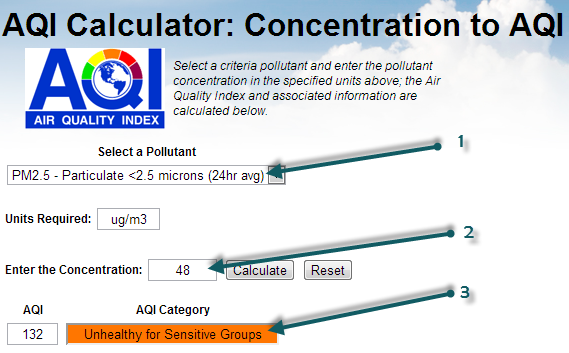In April 2014, the Singapore NEA has updated the PSI calculation to also include PM2.5. http://www.nea.gov.sg/anti-pollution-radiation-protection/air-pollution-control/psi
With the recent Southeast Asia Smog from Indonesia affecting Singapore and now Malaysia, we got many questions about why there is a difference between the data which can be read from Singapore NEA website (nea.gov.sg) and the World Air Quality Index project Singapore webpage.
예를 들어, 오늘 NEA 웹사이트에서 읽을 수 있는 내용은 다음과 같습니다.

몇 가지 역사적인 이유로 싱가포르는 대기 질을 평가하기 위해 PSI ( 오염 물질 표준 지수 )를 사용하고 있습니다. 위 이미지에서 숫자 1은 PSI 평가에 사용되는 PM10 값에 해당합니다. 값 67(/59) PSI 59에 해당하는 67μg/m3로 읽을 수 있습니다. PSI는 각 오염물질(PM 10 , SO 2 , NO 2 , O )에 대한 개별 PSI의 최대값으로 평가됩니다. 3 (오존) 및 CO 2 .
PSI(Singapore-North) = max( PSIPM10-based, ... PSIO3-based )= max (59, ..., 77) = 77
즉, 흥미로운 점은 동일한 테이블에서 PM2.5 데이터가 마지막 열에도 제공된다는 것입니다(3 참조). 이 데이터는 μg/m3 단위로만 제공되며(2 참조) PSI와 같은 변환(예: PM2.5 질량을 오염 또는 품질 지수로 변환)은 없습니다. 그러나 이러한 변환은 존재하며 미국 환경 보호국 에 의해 정의됩니다. 변환을 수행하는 가장 쉬운 방법은 airnow.gov 에서 제공되는 온라인 계산기를 사용하는 것입니다.

If you select the PM2.5 (1), then enter the mass concentration of 48 (2), can click on Calculate, you will obtain the AQI of 132 (3). So, based on the PM2.5 AQI conversion, the PSI that is used for Singapore could be extended (let's call it PSI++) to also take into account the PM2.5 information. In which case, the PSI++ would be the maximum of the regular PSI (based on PM10 only) and the PM2.5 AQI:
PSI++ = max( PSI, AQIPM.25 ) = max( 77, 132 ) = 132
This PSI++, that is commonly referred as AQI (or Air Quality Index), is what is being used on the the World Air Quality Index project, for all the cities (provided PM2.5 is available for the city). And this explains why the values are different between the NEA website and the World Air Quality Index project.
Moreover, when doing the convertion, make sure you use the 1-hour reading for the PM2.5 concentration rather than the 24-hours averaged value, as shown on the below image:

http://www.haze.gov.sg/haze-updates/pollutant-concentrations/type/PM25-1Hr
If you want to know more about PM10 vs PM2.5, and especially why PM10 is still used, please check the faq entry about why is PM2.5 often higher than PM10? Is PM10 still a relevant measure?
--
For more information about specific countries or continent, please refer to those articles: Thailand and Malysia - India - China - Hong Kong / Canada (Air Quality Health Index) - South America - Australia - Quebec and Montreal - Singapore - Poland - Indonesia .
For information about the 24 hours averaging used or Ozone and Particulate Matter (PM2.5), please refer to those two articles: Ground Ozone Index - PM2.5 Instant Cast
